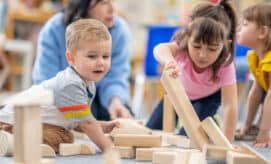As educators, our mindsets have a big impact on the children that we care for. When we enter the classroom with a positive attitude, it helps to create a more joyful mood in the classroom, and creates a safe space in which children feel free to explore and learn. In this article, we share why maintaining a positive mindset is so beneficial, along with simple practices for creating happier classrooms and programs.
What Does Positivity Look Like In the Classroom?
Having a positive mindset doesn’t mean that there are no challenges. Everyone has bad days, and sometimes we don’t feel at our best. Maintaining positivity in the classroom means finding healthy ways to cope with stress so that it doen’t impact your interactions with children.
Positivity can also mean finding the silver lining in difficult situations. You will likely encounter challenges in your work, but these challenges can also point to opportunities to uncover new approaches to classroom activities and routines. Trying to find the bright spots helps to maintain a happy classroom. It also demonstrates to children what it looks like to move forward, even in the face of adversity.
Mr. Rogers often reassured adults and children that it’s okay to feel whatever we feel, but what we do with those feelings is important. He reminded us that we can demonstrate to the children in our care that “they can be angry and not have to hurt themselves or anybody else, that they can have the full range of feelings and express them in very healthy, positive ways.”
Why It Matters
Your Positive Mood is Contagious
Your demeanor in the classroom or program has a significant impact on the overall mood of the children and the space, and when you enter your classroom with happiness, that positive energy spreads.
Jon Gordon, author of The Power of Positive Leadership, notes that “Sincere smiles, kind words, encouragement and positive energy infect people in a positive way. On the flip side your students are just as likely to catch your bad mood…So each day you come to school you have a choice…When you choose to be positively contagious your positive energy has a positive impact on your students, your colleagues, and ultimately your school culture. Your students will remember very little of what you said but they will remember 100% of how you made them feel.”
Positive Interactions Create Safe Learning Spaces
Positive interactions with children help to build motivation, by creating a safe, supportive, and encouraging learning environment. When we offer children comfort in difficult moments, or praise when they have accomplished something, they feel safe, valued, and cared for. These positive interactions help to build relationships with children and ultimately support their learning!
Practices for Building A More Positive Mindset
-
Find humor in the difficulties. The truth is, working with young children is unpredictable. There will be times when your plans don’t work out, and that’s okay! Find ways to laugh at the silliness of working with young children. When an activity doesn’t work out, or things fall apart…sometimes laughter really is the best medicine!
-
Bring “happy” items into the classroom. What makes you happy? If you love flowers, pick a few fresh flowers to display in your classroom. Maybe you love hiking, or your pet, or spending time with your family. Bring some photos into your classroom of some of your favorite things (or people!) to provide you with some happiness and positivity throughout the day.
-
Talk to children about your feelings. Children learn so much from observing our behavior. In difficult situations, we can talk to children about how we are feeling, and how you are handling those emotions. For example, if you had an exciting activity planned, and it didn’t work out, talk about it with the children: “I’m feeling really sad that we didn’t get to do our project today too. It can feel disappointing when we’re excited about plans and they don’t work out. But, I had an idea for another fun game that we can play now that we have some free time.”
-
Allow yourself time and space to process your feelings. As much as we try to stay positive, some days will be hard. If you had a busy morning at home before coming to work, give yourself a minute or two before going into the classroom to decompress. Take a few deep breaths, and acknowledge your feelings before jumping into a busy day in the classroom.
-
Celebrate the victories. Young children remind us to find joy in the little things. When we choose to focus on the good, it can help us to feel more positive, especially during challenging times. Share positive stories with parents in an email or newsletter, or keep a gratitude journal to keep track of these special moments.





